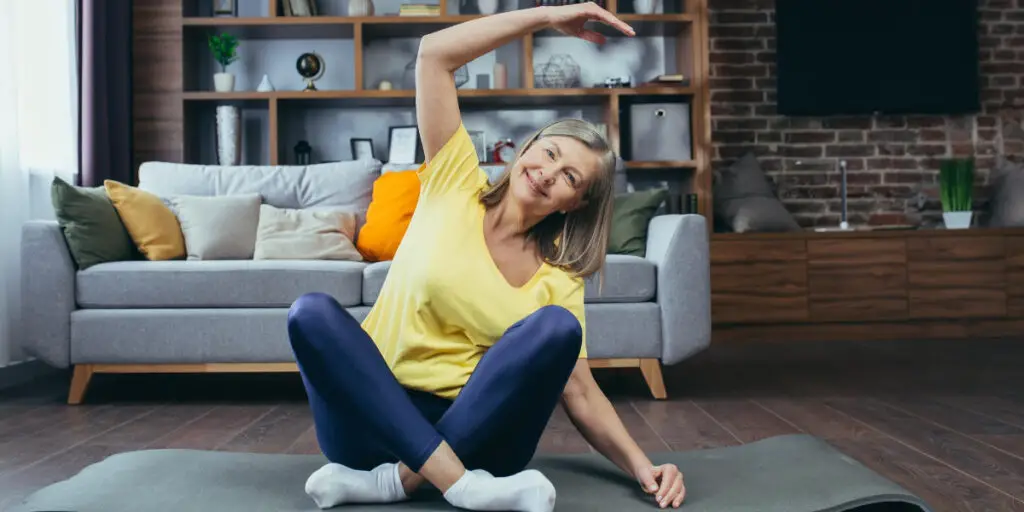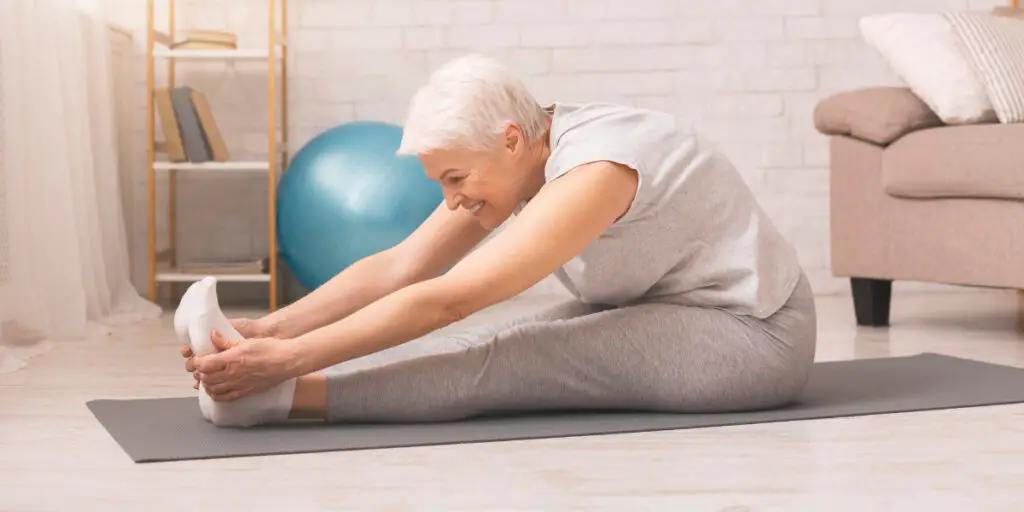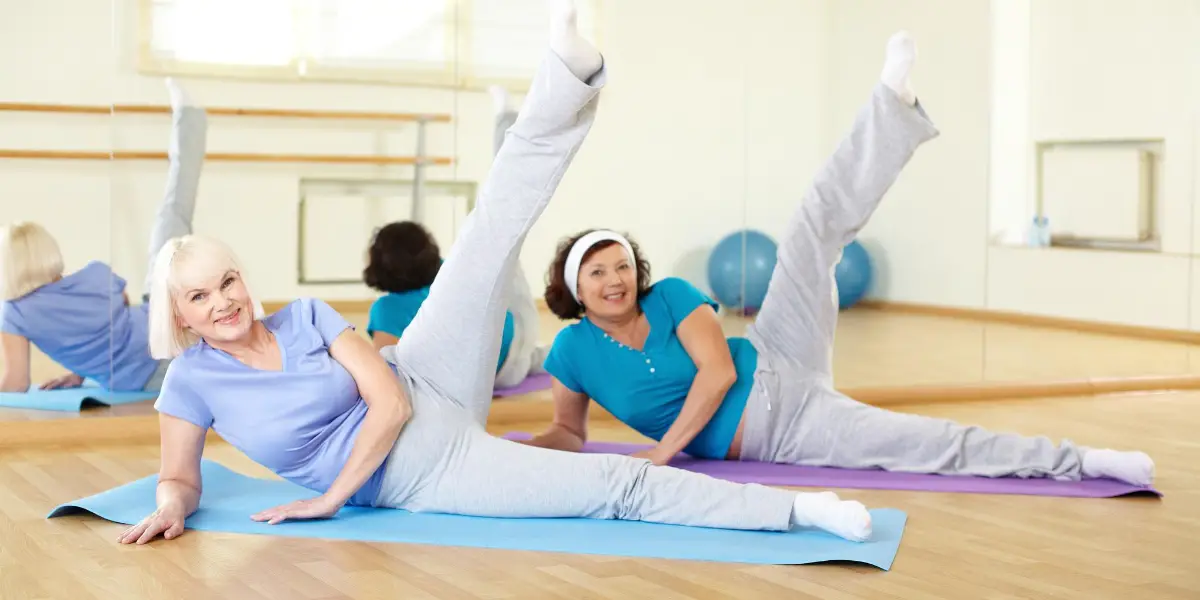One of the things that’s always bothered me as a Pilates instructor is the general perception that Pilates is for young women. It’s true that many forms of exercise are better suited to the young, so is Pilates suitable for the elderly?
Yes, Pilates is ideal for anyone over 60 years old who wants to improve their fitness levels. The exercises in Pilates focus on core strength, balance and flexibility. These three areas are important for everyone at any age.
It’s worth remembering that the founder, Joseph Pilates, first created a series of exercises for the purpose of rehabilitation.
It can be a great exercise for the elderly, and some benefits include: increased flexibility, strength, balance and coordination; improved posture. However, it is important to speak with a qualified instructor about specific plans for older adults in order to make sure that they are doing the class correctly and safely.
There are many reasons why Pilates could be a good choice for seniors. For starters, it is low impact, which can be helpful for those who are recovering from an injury or who have low-impact needs.
Additionally, Pilates comes in many forms and intensities, making it a versatile option that can be tailored to meet the specific needs of each person.
Finally, it is gentle and low risk, making it ideal for seniors who want to get some exercise without putting too much stress on their bodies.

What are some benefits of Pilates for seniors?
There are many health benefits to Pilates for seniors. First and foremost, it is a low impact exercise that is gentle on the body. This makes it perfect for any age group and can be modified to meet your needs.
As a low intensity and low risk, making it ideal for those who want to exercise but don’t want to build muscle mass or experience high impact on their joints.
In addition, it is popular among seniors because it helps improve balance and stability as well as align the spine. It is also great for improving strength, flexibility, and coordination–all while being easy on the joints.
If you attend classes at a Pilates studio, you’ll also benefit from the social side of taking a long term workout program. There is usually a range of classes to cater for beginners through to advanced practitioners and by going regularly you’ll get to know others attending, and often there will be social events arranged by the instructor or Pilates studio.
Finally, because it can be done in the comfort of one’s own home or with a trainer, it is a convenient option that doesn’t require travelling or joining a gym.
What is the difference between chair and mat Pilates?
It’s a testament to the versatility of Pilates that it can be adapted to different uses and situations.
The difference between chair and mat Pilates is that in chair Pilates, you are seated the entire time, while in mat Pilates you move between different positions, sometimes you are lying down on the floor, sometimes you are standing, sometimes you’re on your knees.
The use of a chair makes Pilates accessible to those with mobility issues as they don’t require physical fitness to get up and down on the mat.
The use of a chair does reduce some effectiveness; you can’t do all the same moves as you would normally do on a mat, and it reduces the body weight used when working out, but it is far better to do some exercise on a chair than no exercise at all.
Seniors should start slowly with gentle movements until they get used to them before trying new stretches that require more flexibility. If a stretch feels too difficult, modify or skip it and focus on the ones you can do with success. Remember to always listen to your body and don’t push yourself too hard!
Is Pilates suitable for seniors with mobility issues?
There’s no doubt that Pilates is a great workout for people of all ages, but it can be especially beneficial for seniors with mobility issues. Chair and mat workouts are both excellent options to help improve strength, flexibility, and balance.
Pilates is designed to work within a person’s current state, so you don’t need to worry about hurting yourself by trying too hard. If something hurts, stop doing it!
You should also aim to keep your spine in a neutral position during exercises and allow your body to relax with the help of gravity. These simple tips will make your Pilates workout safer and more comfortable.
How can Pilates help improve balance and coordination in seniors?
There are many benefits to Pilates for seniors. For one, it can help improve the strength and flexibility of those who participate.
Additionally, as seniors improve their balance, posture, and pose, they become less likely to fall. What’s more, it is an exercise that can improve balance and coordination in those who partake.
Just be sure to check with your teacher before attempting any new exercises; some moves may be too strenuous or dangerous for those just starting out.
And remember: always practice caution when engaging in any physical activity. With proper instruction and supervision, however, Pilates can be a safe and gentle way for seniors to stay healthy and active.
What are some other benefits of Pilates for seniors?
In addition to the many benefits that Pilates offers for seniors, such as improving balance and strength, Pilates is also a gentle exercise that can be done every day without modifications. This is great because it means that seniors can easily integrate it into their lifestyle without having to worry about making time for a special class or finding an activity that is gentle enough.

Pilates has even been shown to help improve mental health in seniors by reducing stress levels and promoting relaxation. In fact, one study found that after eight weeks of doing Pilates twice a week, participants showed significant decreases in cortisol levels (a hormone associated with stress) and increases in serotonin levels (a hormone associated with happiness). Additionally, another study found that Pilates was effective at reducing anxiety in elderly people.
So not only does Pilates provide physical benefits like improved balance and muscle strength, but it can also promote better mental health for seniors. This makes it an important activity to consider if you’re looking for ways to stay healthy both physically and mentally as you age.
If you want to see more benefits, check out The many benefits of Pilates
Can you do Pilates if you have arthritis?
It is possible to do Pilates if you have arthritis, but it may be more difficult because the exercises may be harder to do.
Research indicated that those who take up Pilates experience a significant improvement regarding fatigue, depression, aerobic capacity, and quality of life.
You may need to modify the movements so that they are easier for you. Your doctor or physiotherapist can help you decide what modifications you need to make.
How often should seniors do Pilates to see results?
Like with any other form of exercise, the more you do Pilates, the better the results will be. However, it’s important to find a level that is challenging but not too difficult for someone to struggle with.
The UK National Health Service recommends adults have regular exercise to ensure a good quality of life. Those aged 19 to 64 should aim to:
do strengthening activities that work all the major muscle groups (legs, hips, back, abdomen, chest, shoulders and arms) on at least 2 days a week
do at least 150 minutes of moderate intensity activity a week or 75 minutes of vigorous intensity activity a week
spread exercise evenly over 4 to 5 days a week, or every day
reduce time spent sitting or lying down and break up long periods of not moving with some activity
NHS
And for adults aged 65 and over the NHS recommendation is you should:
aim to be physically active every day, even if it’s just light activity
do activities that improve strength, balance and flexibility on at least 2 days a week
do at least 150 minutes of moderate intensity activity a week or 75 minutes of vigorous intensity activity if you are already active, or a combination of both
reduce time spent sitting or lying down and break up long periods of not moving with some activity
NHS
Pilates can help people of all ages achieve these recommendations. For those with any existing issues or who are recovering from injury or operation, for example a hip replacement, a doctor or physical therapist should be consulted. They can be a great source of information when it comes to what exercises are needed for recovery and how often they should be done.
Where can I find a qualified instructor to teach me Pilates?
Most studios offer Pilates classes and instructors to fit your needs. Confirm the quality of their instructor with these questions before signing up:
- Have they completed a comprehensive training program?
- Do they have experience working with seniors?
- Do they have props, like a bolster, on hand for use during classes if necessary?
Even if they don’t have a “senior-specific” Pilates class, remember that it is not necessary that the studio separates their classes by demographics; they will usually either seperate classes by ability, or provide modifications for those struggling with moves.
Can I do Pilates at home if I don’t have access to a studio or gym?
Yes, you can do Pilates exercises at home if you don’t have access to a studio or gym. However, it’s important to be aware that doing Pilates at home can be more risky than in a professional setting because there is less supervision and people are often less likely to perform the exercises correctly. It’s also important to make sure that you have the right equipment for Pilates before getting started.
I would always strongly recommend you seek tuition from a qualified professional before trying on your own. A qualified instructor will demonstrate how to do moves to fit in with your current capabilities They can help you with a fitness program that includes ‘homework’ for you to do outside of class.
Are there any risks associated with doing Pilates as a senior citizen?
Overall Pilates is a low risk option for seniors. As mentioned, it’s important to initially exercise with a knowledgeable instructor who is aware of any specific back problems to avoid risk of self injury.
In addition, the Pilates system’s exercises should be demanding mentally and physically, but they shouldn’t cause too much difficulty for people to struggle. This is why it is important that seniors take things slowly at first and work their way up to more challenging exercises.
Pilates is gentle enough for people of all ages; however, individuals can tailor each exercise to their needs on any given day, based on age and physical condition.
For example, if an older adult feels like they can handle more strenuous activity that day, then they are welcome to do so! On the other hand, if someone feels like they need a slower-paced workout then they can easily modify the exercises to meet their needs.
Overall, Pilates offers many benefits for seniors–such as improved concentration, endurance, balance and determination–which help them age gracefully.
Who can benefit from doing Chair and Mat Pilates
There are many benefits to doing Chair and Mat Pilates for seniors. In fact, almost anyone can benefit from these exercises!
Chair Pilates is a great place to start if you’re new to Pilates or if you’re not able to do traditional floor exercises. They can be practised with feet closer together, or spread out, and they’re an option for those who need to sit or stand but don’t have the clearance.
Chair Pilates can also be used in place of a floor exercise, and provide a good core workout. Plus, the chair gives feedback on the pelvis and spine, without the need for full weight-bearing exercises. So if you’re looking for a low-impact way to stay active and improve your overall fitness level, give Chair Pilates a try!
Final thoughts
I have clients of all ages and it might surprise you to learn some of my older clients are in better shape than younger clients!
It can be a long journey, and don’t be put off when you read that Pilates exercise programs will give you strong core muscles, this isn’t about getting a 6 pack, it’s about improving your functional movement so that your day to day activities are more enjoyable.
Sources:
https://www.nhs.uk/live-well/exercise/exercise-guidelines/physical-activity-guidelines-older-adults/
https://link.springer.com/article/10.1007/s11845-020-02412-2




